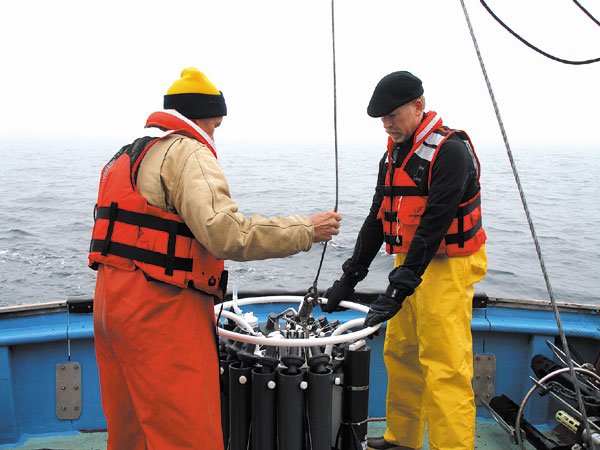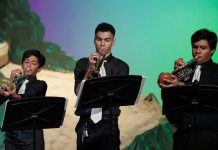Jeff Manker heads to Barrow, Alaska to study climate and the
bowhead whale
Gilroy – Every year, Gilroy High School marine science teacher Jeff Manker assigns a project to his students: If you could go anyplace in the world, determine how you would get there, describe what you would see and an organism you would study.
This summer, Manker had an opportunity to put his assignment to a real life test.
He boarded a plane mid-August at Mineta San Jose International Airport – there were no roads to take him where he was going.
Manker changed flights in Seattle, then Anchorage, and on to Fairbanks where he took a cargo plane to the top of the world – Barrow, Alaska.
The community is the northernmost point in the United States, located about 350 miles north of the Arctic Circle and is home to 4,500 residents – most who are Inupiat, also known as Eskimos. The water temperature is just above freezing and the air isn’t much warmer. But despite the cold, Barrow is a “hotspot for education,” Manker said.
Bundled in fleece, he began a 10-day research project studying climate changes, its effects on the bowhead whale and in turn, the Inupiat people who hunt them.
Manker was one of 12 teachers nationwide selected to participate in studies across the world through the ARMADA project – a group that matches research opportunities with master teachers based upon their interests.
“The goal of the ARMADA project is to reinvigorate teachers and give them a hands on, real life work experience,” said Manker, who has been teaching for 20 years.
“I would encourage any teacher who gets an opportunity like this,” he said.
In exchange for the trip, funded by the National Science Foundation, Manker will provide mentoring services for a new science teacher at GHS.
He applied last February for the grant. He found out a month later that he was selected.
When posed with the question: “Where do you want to go?” Manker elected for “someplace cold” and was paired with members of the Study of the Northern Alaskan Coastal System to study Arctic birds aboard a 43-foot fishing boat.
An expert in birds, Manker became known to the eight other crew members as “the bird man.” In addition to identifying the species and location of birds he observed – Manker was assigned duties such as monitoring the measurement of the ocean water for salination, temperature and density of photosynthetic plankton.
By noting changes in the water researchers can make connections about the migrating patterns of bowhead whales – one of the primary sources of food for the Inupiat people.
“I actually felt like I was making a contribution,” Manker said. “I’m not an oceanographer – I am a teacher. I feel like I learned how they really did the science – not just from books.”
But the trip was more than science. Manker learned about the Inupiat people and how their culture is built upon a close relationship with the bowhead whale.
While the species is endangered, the Inupiat people are allowed to hunt the whale because they have relied upon it for survival for 2,500 years. The Inupiat farm only what they need and scientists are learning more about the bowhead whale through the Inupiat’s observations while hunting, Manker said.
“I really came to respect and admire what they do,” he said. “In this case, you feed your village. Everyone has a part.”
Whether the position is participating in the actual hunt or preparing the food afterwards – everyone has an active role in the community.
Part of the ARMADA project’s role is inform the general public about the research currently under way . Without teachers to disperse information to students, only individuals who subscribe to various science journals would know it existed at all.
“The scientist gets to see how their work applies to the greater public … They’re researchers – they’re not teachers,” Manker said.
According to Manker, storms and rough seas put the crew on a tight schedule.
“Whenever conditions were good we went,” Manker said. If that meant staying at sea until 4am and sleeping six hours on land before returning to the icy waters – they did. Conditions were cramped. Manker described in his journal: They worked hip to hip. When on land, signs warned of polar bears. Houses are built on stilts so as not to melt the tundra floor.
For miles at sea, there was not a bird in the sky. The boat transected the Arctic and Pacific waterways. Suddenly clusters of birds would be overhead. Manker’s sightings correlated with changes in the ocean the scientists had observed.
“When I got to see the connections between the ocean and the creatures on the surface – making that connection was very exciting for me,” he said.
The 46-year-old has traveled to 27 countries. He tries to communicate to his students the importance of travel along with his passion for marine science. Since GHS first offered marine science three years ago, the number of classes has doubled. Some students have returned to tell Manker that they, too, took their dream trip.
Manker returned from Barrow just seven hours before school started Aug. 29.
He will teach his classes what he learned through the ARMADA project. He has brought samples of muktuk – bowhead whale blubber – back for his colleagues and students to taste.
According to Manker, the skin has the consistency is of a wetsuit, and blubber – that of old Jello – with a taste reminiscent of seaweed.
“As a group, teachers are willing to try anything,” he said. “I saw lots of things that I’d never seen. I got to add to my life list … I’m going to bring some (muktuk) in and see if there are any takers.”














